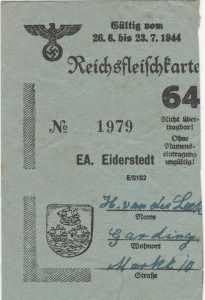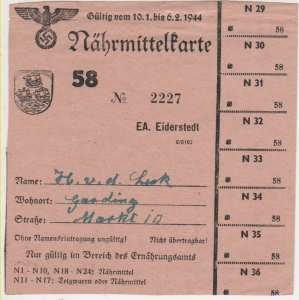Like almost every other country involved in WWII, Germany had a system of rationing in place. You needed to go with your identification (and if you were Jewish, your card would be stamped with a J) and your money to buy the cards. Just having the card didn’t guarantee you would get the items. Especially toward the end of the war, the items simply weren’t available. And just about everything was rationed, down to clothes and shoes.
Pregnant women and those with jobs demanding hard physical labor got a large allotment of calories. By the end of the war, the average German got about 1600 calories per day. The number continued to drop after the war as Germany lay in shambles and the Soviets blockaded Berlin. Of course, many participated in the black market and, if they had enough of money, they could supplement their diet.
 |
| This is a meat ration card. This person used up all the coupons. |
 |
| This is a milk ration card. It looks to be pretty complete. |
 | ||||||||||||
| This one is for “nutrients”. It still has several coupons. |
Housewives became very creative with the food they were able to get. They could make something special out of very little. That will be another post. But imagine not being able to go to the grocery store and not being able to buy whatever you wanted – and finding most of the shelves bare. To us in the United States, it’s incomprehensible.
If you had to ration your food, what could you do without?


Brussel sprouts. The airmen based in England had to eat a lot of those.
I don’t eat pork or red meat, so they could be rationed.
If my food allergies were rationed (wheat, soy, corn, milk, chocolate), I’d be sure to eat healthy!